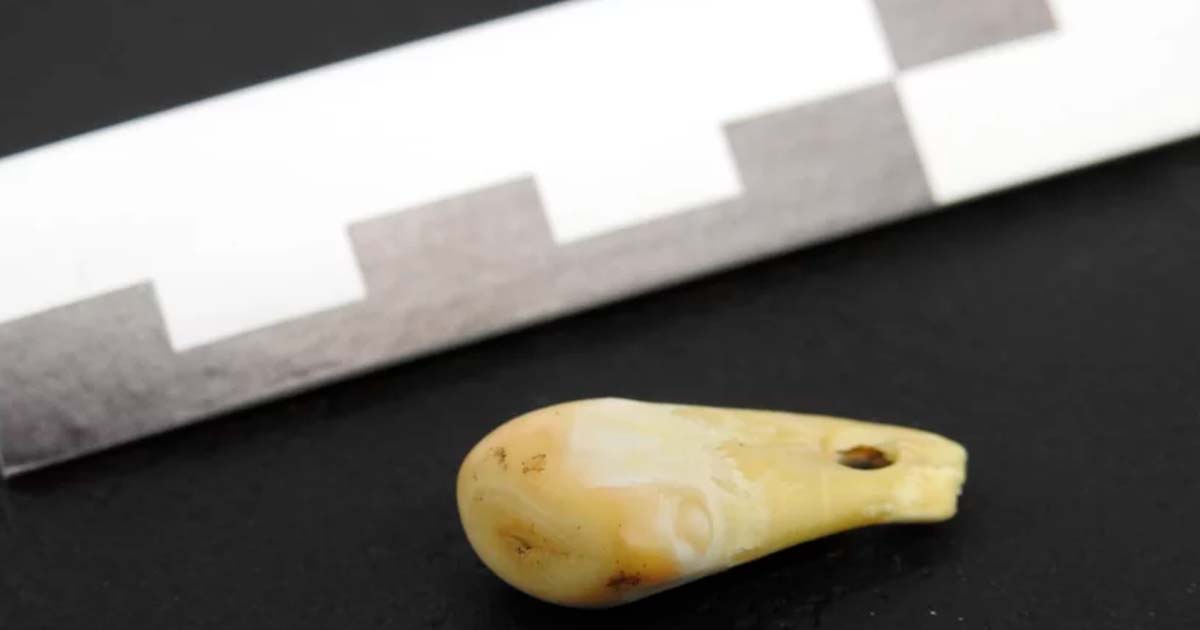

Achieving an historic and groundbreaking first, an international team of scientists from the Max Planck Institute for Evolutionary Anthropology in Leipzig, Germany have successfully extracted intact human DNA from a Paleolithic period (pre-10,000 BC) artifact. From this they discerned personal details about the person who wore the pendant and even where she came from.
The item that produced this startling evidence of ancient human activity was a pierced deer tooth that had once been worn on the string of a pendant. It was found at the famous Denisova Cave in the Altai Mountains of southern Siberia, which at different times was occupied by humans as well as by their long-extinct cousins, the mysterious Denisovans.

Artistic interpretation of the pendant with dark DNA cordage. (© Myrthe Lucas/Nature)
From the DNA samples they obtained, the researchers were able to reconstruct the genetic profile of the person who wore the pendant in prehistoric times, between 19,000 and 25,000 years ago. They were able to establish that the pendant’s owner was a woman, and that she had been closely related to the Ancient North Eurasian people who mostly lived further east in Siberia during the Paleolithic.
“Forensic scientists will not be surprised that human DNA can be isolated from an object that has been handled a lot,” said evolutionary geneticist and study co-author Matthias Meyer in a Max Planck institute press release. “But it is amazing that this is still possible after 20,000 years.”

The Pierced deer tooth discovered from Denisova Cave after DNA extraction. (© Max Planck Institute for Evolutionary Anthropology/Nature)
A New Method for DNA Extraction Opens Doorway to the Past
So how exactly did the researchers manage to retrieve DNA samples from an object that was left in a cave 20,000 years ago? To accomplish this remarkable feat, they used a brand-new method for DNA extraction and isolation that they themselves developed, specifically for use when searching for genetic material in ancient bones and teeth.
As the scientists explain in a new article appearing in Nature, the technique they developed is unique because it is entirely noninvasive and nondestructive. It is also quite simple. It only requires the tooth or piece of ancient bone to be vigorously washed in a solution that contains phosphate and warm water. This liquid will completely clean the surface of a tooth or bone, rinsing out the pores and washing away any genetic material that might have been trapped and preserved on the interior or exterior of the artifact. The DNA can then be isolated and extracted from the washing solution, in a pristine state if the procedure has been implemented correctly.
“One could say we have created a washing machine for ancient artifacts within our clean laboratory,” said study lead author Elena Essel, the Max Planck researcher credited with inventing this DNA extraction technique. “By washing the artifacts at temperatures of up to 90°C, we are able to extract DNA from the wash waters, while keeping the artifacts intact.”
For this type of study to take place, it was essential that a method for DNA retrieval that caused no damage to bones or teeth be developed.

Lead author Elena Essel working in the clean laboratory on the pierced deer tooth discovered from Denisova Cave. (© MPI f. Evolutionary Anthropology/Nature)
“The surface structure of Paleolithic bone and tooth artifacts provides important information about their production and use,” explained Marie Soressi, an archaeologist from the University of Leiden who worked with the Max Planck Institute scientists in this study. “Therefore, preserving the integrity of the artifacts, including microstructures on their surface, was a top priority.”
While stone tools from ancient times are found more often than artifacts made from teeth and bones, the latter are preferable for DNA extraction. This is because they are porous and therefore able to absorb traces of human DNA found in sweat and skin cells more easily.
The Dawning of a New Age in Ancient DNA Research
The Max Planck Institute scientists believe their technique for DNA extraction will usher in a new era in ancient genetic research.
Tools, jewelry, and personal items made from stone, bones and teeth can provide important data about the social standards and cultural practices of Paleolithic peoples. But archaeologists and anthropologists have been limited in their studies of such items, by the fact that it has been impossible to link specific artifacts with specific individuals. That makes it difficult to draw conclusions about how societal and cultural roles were filled by people of different genders and age groups.
But this new methodology for DNA extraction will change everything. It will allow scientists to link DNA samples to specific ancient artifacts, meaning they will be able to create detailed genetic profiles of the people who used or wore these objects.
“Our work highlights that artifacts made from bones or teeth are a previously untapped source of ancient human DNA that can provide insights about the ancestry and biological sex of the individuals who handled, carried or wore these objects in the deep past,” the study authors wrote in their Nature article.
The scientists plan to use this methodology to remove and examine DNA samples from other Paleolithic artifacts made from bone and teeth, which are currently held in collections at universities and in museums across the world. Their efforts, and the efforts of others who adopt their DNA washing technique, will help unlock many of the secrets of prehistoric Paleolithic cultures, revealing the similarities and differences between those cultures and our own.